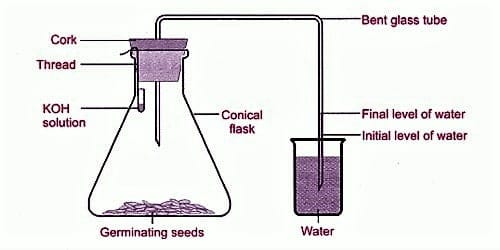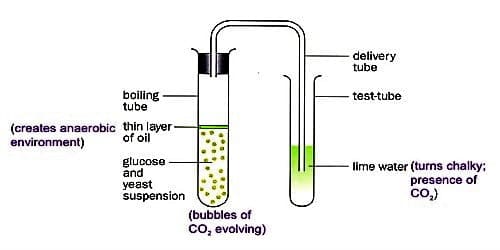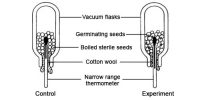Anaerobic respiration is a simpler procedure that does not necessitate oxygen. However, anaerobic respiration does not produce or arise as many ATP (System). Fermentation (System) is one type of anaerobic respiration. Lactic acid fermentation is followed by some bacterial species for ATP production (It is the most common method). Alcoholic fermentation is a procedure that takes place in yeast cells. You might be familiar with some of the products created through alcoholic fermentation such as alcohol mixed product, wine, and bread.
Principle:
- In the absence of oxygen, yeast will undergo anaerobic respiration. Yeast converts glucose into ethanol and carbon dioxide. So, the carbon dioxide given out reflects the rate of anaerobic respiration.
- Glucose was fermented because this sugar can pass rapidly into the cell and enter directly into metabolic pathways
Requirements: One small beaker, one test tube, a stand with clamp, mercury, some gram seeds, a piece of caustic potash and a pair of forceps. Besides, Germinating seeds, a test tube, mercury, Potassium hydroxide (KOH) crystals, petri dish, etc. may also require if you needed.
Apparatus: Yeast, Glucose powder, Ice, Conical flask, Bunsen Burner, Co2 Sensor, Paraffin oil, Beaker, etc.
Procedure
Here some part filled up the beaker with mercury or related items. The mercury is filled in the test tube up to the rim. Fill up a test tube fulfill with mercury or related items and invert it with the help of the thumb or anything suitable and put it in the beaker containing or preserve mercury. Take a petri dish full of mercury and put the mercury filled test tube in the inverted condition with the help of thumb. Now keep the test tube upright by clamping with a stand in such a condition as if the mouth of the test tube remains in the mercury but not touching the bottom of the beaker. The thumb is removed inside the petri dish. Now introduce some germinating gram seeds into the test tube with the help of a pair of forceps. As the seeds are lighter than mercury, they will float over Mercury. Leave the experimental set for observation. Let this apparatus be put as such for some time.

Fig. The experiment of Anaerobic Respiration
Observation
After a few hours letter, it will be seen or observe that the mercury at the upper portion of the test tube has displaced downwards by a gas released by germinating gram seeds. Now introduce the caustic potash stick into the test tube with the help of a pair of forceps. It will be observed that the test tube is completely filled up with the displaced mercury as the gas is absorbed by caustic potash stick.
After some time the mercury level in the test tube goes down. Now introduce some Potassium hydroxide (KOH) crystals in the above test tube. After a little while, the mercury level will go up to the former position.
Explanation
The lowering of mercury level in the test tube indicates that some gas has been released by germinating seeds. Only Carbon Dioxide (CO2) gas may be absorbed by Potassium hydroxide (KOH) crystals. We see that with the introduction of Potassium hydroxide (KOH) crystals the level of mercury goes high, hence the seeds have released Carbon Dioxide (CO2) under the anaerobic conditions.
Conclusion: The gas is absorbed by caustic potash so it was Carbon Dioxide (CO2) and respiration of gram seeds released the gas. Air cannot be present in the mercury and the gram seeds were present in mercury. So the respiration of gram seeds was anaerobic. Therefore in anaerobic respiration O2 is not required.














